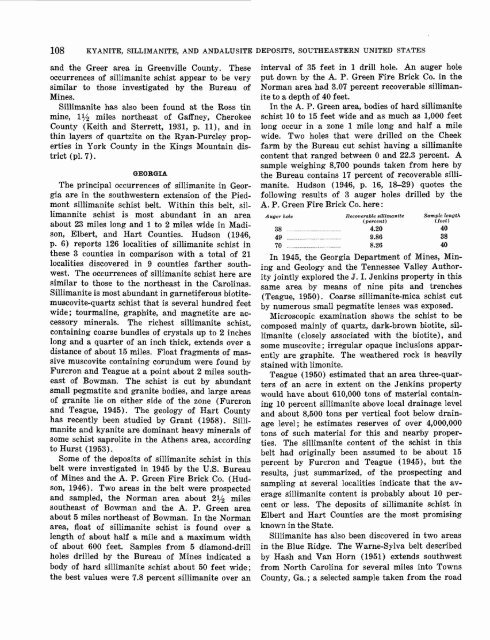Kyanite, Sillimanite, and Andalusite Deposits of the Southeastern ...
Kyanite, Sillimanite, and Andalusite Deposits of the Southeastern ...
Kyanite, Sillimanite, and Andalusite Deposits of the Southeastern ...
You also want an ePaper? Increase the reach of your titles
YUMPU automatically turns print PDFs into web optimized ePapers that Google loves.
108 KYANITE, SILLIMANITE, AND ANDALUSITE DEPOSITS, SOUTHEASTERN UNITED STATES<br />
<strong>and</strong> <strong>the</strong> Greer area in Greenville County. These<br />
occurrences <strong>of</strong> sillimanite schist appear to be very<br />
similar to those investigated by <strong>the</strong> Bureau <strong>of</strong><br />
Mines.<br />
<strong>Sillimanite</strong> has also been found at <strong>the</strong> Ross tin<br />
mine, 11/2 miles nor<strong>the</strong>ast <strong>of</strong> Gaffney, Cherokee<br />
County (Keith <strong>and</strong> Sterrett, 1931, p. 11), <strong>and</strong> in<br />
thin layers <strong>of</strong> quartzite on <strong>the</strong> Ryan-Purcley properties<br />
in York County in <strong>the</strong> Kings Mountain district<br />
(pi. 7).<br />
GEORGIA<br />
The principal occurrences <strong>of</strong> sillimanite in Georgia<br />
are in <strong>the</strong> southwestern extension <strong>of</strong> <strong>the</strong> Piedmont<br />
sillimanite schist belt. Within this belt, sillimannite<br />
schist is most abundant in an area<br />
about 23 miles long <strong>and</strong> 1 to 2 miles wide in Madison,<br />
Elbert, <strong>and</strong> Hart Counties. Hudson (1946,<br />
p. 6) reports 126 localities <strong>of</strong> sillimanite schist in<br />
<strong>the</strong>se 3 counties in comparison with a total <strong>of</strong> 21<br />
localities discovered in 9 counties far<strong>the</strong>r southwest.<br />
The occurrences <strong>of</strong> sillimanite schist here are<br />
similar to those to <strong>the</strong> nor<strong>the</strong>ast in <strong>the</strong> Carolinas.<br />
<strong>Sillimanite</strong> is most abundant in garnetiferous biotitemuscovite-quartz<br />
schist that is several hundred feet<br />
wide; tourmaline, graphite, <strong>and</strong> magnetite are accessory<br />
minerals. The richest sillimanite schist,<br />
containing coarse bundles <strong>of</strong> crystals up to 2 inches<br />
long <strong>and</strong> a quarter <strong>of</strong> an inch thick, extends over a<br />
distance <strong>of</strong> about 15 miles. Float fragments <strong>of</strong> massive<br />
muscovite containing corundum were found by<br />
Furcron <strong>and</strong> Teague at a point about 2 miles sou<strong>the</strong>ast<br />
<strong>of</strong> Bowman. The schist is cut by abundant<br />
small pegmatite <strong>and</strong> granite bodies, <strong>and</strong> large areas<br />
<strong>of</strong> granite lie on ei<strong>the</strong>r side <strong>of</strong> <strong>the</strong> zone (Furcron<br />
<strong>and</strong> Teague, 1945). The geology <strong>of</strong> Hart County<br />
has recently been studied by Grant (1958). <strong>Sillimanite</strong><br />
<strong>and</strong> kyanite are dominant heavy minerals <strong>of</strong><br />
some schist saprolite in <strong>the</strong> A<strong>the</strong>ns area, according<br />
to Hurst (1953).<br />
Some <strong>of</strong> <strong>the</strong> deposits <strong>of</strong> sillimanite schist in this<br />
belt were investigated in 1945 by <strong>the</strong> U.S. Bureau<br />
<strong>of</strong> Mines <strong>and</strong> <strong>the</strong> A. P. Green Fire Brick Co. (Hudson,<br />
1946). Two areas in <strong>the</strong> belt were prospected<br />
<strong>and</strong> sampled, <strong>the</strong> Norman area about 21/2 miles<br />
sou<strong>the</strong>ast <strong>of</strong> Bowman <strong>and</strong> <strong>the</strong> A. P. Green area<br />
about 5 miles nor<strong>the</strong>ast <strong>of</strong> Bowman. In <strong>the</strong> Norman<br />
area, float <strong>of</strong> sillimanite schist is found over a<br />
length <strong>of</strong> about half a mile <strong>and</strong> a maximum width<br />
<strong>of</strong> about 600 feet. Samples from 5 diamond-drill<br />
holes drilled by <strong>the</strong> Bureau <strong>of</strong> Mines indicated a<br />
body <strong>of</strong> hard sillimanite schist about 50 feet wide;<br />
<strong>the</strong> best values were 7.8 percent sillimanite over an<br />
interval <strong>of</strong> 35 feet in 1 drill hole. An auger hole<br />
put down by <strong>the</strong> A. P. Green Fire Brick Co. in <strong>the</strong><br />
Norman area had 3.07 percent recoverable sillimanite<br />
to a depth <strong>of</strong> 40 feet.<br />
In <strong>the</strong> A. P. Green area, bodies <strong>of</strong> hard sillimanite<br />
schist 10 to 15 feet wide <strong>and</strong> as much as 1,000 feet<br />
long occur in a zone 1 mile long <strong>and</strong> half a mile<br />
wide. Two holes that were drilled on <strong>the</strong> Cheek<br />
farm by <strong>the</strong> Bureau cut schist having a sillimanite<br />
content that ranged between 0 <strong>and</strong> 22.3 percent. A<br />
sample weighing 8,700 pounds taken from here by<br />
<strong>the</strong> Bureau contains 17 percent <strong>of</strong> recoverable sillimanite.<br />
Hudson (1946, p. 16, 18-29) quotes <strong>the</strong><br />
following results <strong>of</strong> 3 auger holes drilled by <strong>the</strong><br />
A. P. Green Fire Brick Co. here:<br />
Auger hole<br />
38 .....<br />
49 .....<br />
70 _.<br />
Recoverable sillimanite<br />
(percent)<br />
4.20<br />
9.86<br />
8.26<br />
Sample length<br />
(feet)<br />
40<br />
38<br />
40<br />
In 1945, <strong>the</strong> Georgia Department <strong>of</strong> Mines, Mining<br />
<strong>and</strong> Geology <strong>and</strong> <strong>the</strong> Tennessee Valley Authority<br />
jointly explored <strong>the</strong> J. I. Jenkins property in this<br />
same area by means <strong>of</strong> nine pits <strong>and</strong> trenches<br />
(Teague, 1950). Coarse sillimanite-mica schist cut<br />
by numerous small pegmatite lenses was exposed.<br />
Microscopic examination shows <strong>the</strong> schist to be<br />
composed mainly <strong>of</strong> quartz, dark-brown biotite, sillimanite<br />
(closely associated with <strong>the</strong> biotite), <strong>and</strong><br />
some muscovite; irregular opaque inclusions apparently<br />
are graphite. The wea<strong>the</strong>red rock is heavily<br />
stained with limonite.<br />
Teague (1950) estimated that an area three-quarters<br />
<strong>of</strong> an acre in extent on <strong>the</strong> Jenkins property<br />
would have about 610,000 tons <strong>of</strong> material containing<br />
10 percent sillimanite above local drainage level<br />
<strong>and</strong> about 8,500 tons per vertical foot below drainage<br />
level; he estimates reserves <strong>of</strong> over 4,000,000<br />
tons <strong>of</strong> such material for this <strong>and</strong> nearby properties.<br />
The .sillimanite content <strong>of</strong> <strong>the</strong> schist in this<br />
belt had originally been assumed to be about 15<br />
percent by Furcron <strong>and</strong> Teague (1945), but <strong>the</strong><br />
results, just summarized, <strong>of</strong> <strong>the</strong> prospecting <strong>and</strong><br />
sampling at several localities indicate that <strong>the</strong> average<br />
sillimanite content is probably about 10 percent<br />
or less. The deposits <strong>of</strong> sillimanite schist in<br />
Elbert <strong>and</strong> Hart Counties are <strong>the</strong> most promising<br />
known in <strong>the</strong> State.<br />
<strong>Sillimanite</strong> has also been discovered in two areas<br />
in <strong>the</strong> Blue Ridge. The Warne-Sylva belt described<br />
by Hash <strong>and</strong> Van Horn (1951) extends southwest<br />
from North Carolina for several miles into Towns<br />
County, Ga.; a selected sample taken from <strong>the</strong> road
















